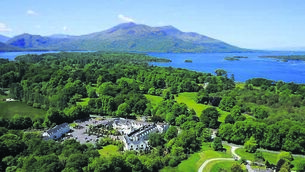When old meets new and two worlds collide in Japan

From its densely populated cities to its lush green rural areas, Japan offers a mix of the traditional and the new, from ryokans to robot-run hotels says,
From the window of the plane, the islands of the southern tip of the Land of the Rising Sun came into view and I felt that all-over frisson of excitement that you get when you find yourself staring at an exotic sight that you’ve never seen before: a warm mist-shrouded series of dark green islands fringed with white sand and blue-green coral waters.
We were visiting Kyushu — the southernmost of the four main islands which, strung together, make up Japan. We landed in its capital Fukuoka.
Like a lot of Japanese cities, it’s a clean, large and somewhat nondescript place with a lively city centre along the waterfront, dominated by colourful neon-lit skyscrapers.
The weather in September can be frequently rainy but always around 30 degrees Celsius. Luckily, the sun was beating down on us gloriously as we boarded the swish Bullet train for an hour-long journey south to the city of Kagoshima.
Here, we met our English guide — a young Englishman named Alex Bradshaw who was well-versed in Japanese culture, having gained martial arts expertise, mastered Japanese and was married with children to a local lady. He even presented his business card in classic Japanese style; held with both hands and accompanied by a bow.
Alex brought us for lunch and our first introduction to Japanese cuisine. It’s very difficult to do justice to the dazzling theatre of convivial eating that typifies the Japanese eating experience.
One of the first surprises was that food was not dominated by fish. In fact, people in Kyushu are known for their great fondness of meat, particularly pork. It’s also one of the parts of Japan most strongly associated with Samurai culture and it was in Kagoshima where the last of the Samurai — having been stripped of their esteemed position in Japanese society by a new regime hell bent on modernisation — made their final stand in 1877.
Alex works for the Shimadzu family – one of Kyushu’s most prominent historical dynasties and his boss Shimadzu-san is a direct descendant of Saigo Takamori, the last Samurai. It was also his ancestors that greeted (or captured, initially) the first recorded Irish visitor to Japan.
He was a Waterford man named Robert Jansen who was picked up off the coast trying to flee the Dutch East India Company in 1704. As a fellow Waterford man, therefore, I had to pay a visit to the Shimadzu feudal home — now a visitor centre in a park on the outskirts of Kagoshima.
In Europe, we’re used to feudal homesteads being imposing stone piles in which wealth is displayed ostentatiously in the form of ornate plasterwork and sweeping staircases.
Their Japanese counterparts are timber homes on one level with lots of paper window panes and bamboo mat flooring. The Lord’s quarters are demarcated only very discreetly by the smallest step and/or a coloured line of texture on the floor.
The onsen — or hot spring bath — is a major part of Japanese life. Throughout the country, there is a proliferation of lava-heated springs bubbling underneath so they are found everywhere. The protocol is to take off all your clothes and not be worrying about who’s looking at you.
Changing areas for men and women are always separate but the spring itself is sometimes mixed. Tattoos are not allowed and you’ll find that virtually nobody in Japan wears a tattoo unless they’re a member of the Yakuza (Japanese mafia).
An hour or so south of Kagoshima lies the island of Yakushima. This idyllic paradise was the setting for Japan’s most famous and successfully commercial animated manga film of all time — Princess Mononoke. Its lush territory is given over almost entirely to a national park, where ancient forests, clear mountain waters and pristine beaches are the order in a realm where sika deer and macaque monkeys live in blissful freedom and harmony. According to Japanese tradition, you can only go to Yakushima “if nature invites you”.
We got a more in-depth taste of an onsen when we stayed in a ryokan (traditional Japanese inn) in the Kyushu countryside. Although Japan is a densely-populated country (it’s about the size of Great Britain but with roughly twice the population), some three-quarters of it are rural.
Outside of its large cities, therefore, there is plenty of mountainous countrysides, where smooth roads wind through bewitching landscape characterised by luminous bright green paddy fields and lush hillsides with a sprinkling of traditional timber houses on the lower reaches.
Our ryokan in Yamabiko was a full-on Shogun experience. Here, the beautiful timber property sits astride a gurgling river and the rooms are of the old style, with simple cupboards, a mattress on the bamboo-mat floor and paper screen doors.

There was no shower (one washes oneself in the outdoor onsen) but there were the modern Japanese conveniences of excellent WiFi, a television showing lots of baseball and sumo wrestling and the amazing Japanese toilet.
This latter device is a very interesting cultural experience. Every home has one, apparently. Even though the notion of connecting a toilet to a mains electrical supply seems like a bad idea to begin with, you’d have to admit that they’re the ultimate in comfort, with their generous-sized oval-shaped heated seat and their array of buttons that allow you to activate the position and strength of the under-carriage cleaning jets of warm water as well as the final flushing mechanism.
From the sublime surroundings of the ryokan, we spent our next night in the slightly ridiculous but thoroughly fascinating accommodation near Nagasaki of the Henn-na-Hotel.
Commonly referred to as the Robot Hotel, it’s the world’s first such establishment staffed by robots. The process of getting checked in at a reception desk manned by two mechanical dinosaurs and a disturbingly glamorous mechanical lady is great fun.
You only need to use your room key once as a face-recognition camera gives you access to your room thereafter. Beside your bed, a pint-sized robot obeys your commands to switch off the lights or turn on the telly.
The lobby features an array of gadgets for sale, some automated vending machines, a grand piano played by a robot and a robotic cloakroom.
The owners envisage opening another 100 of these hotels across South-east Asia over the coming year or so. Apparently, their running costs are much more efficient than with the traditional “human staff” hotel model.
The Robot Hotel is situated at the edge of an enormous theme park — Huis Ten Bosch — which celebrates the famous trading connection between Japan and the Netherlands.
Covering an area larger than Monaco, the park consists of street after street of faithfully recreated Dutch buildings (including a full-scale replica of Amsterdam’s Centraal Station), complete with barges, canals and windmills.
The millions of red bricks needed to undertake this enormous task were shipped from the Netherlands at astronomical cost (the company that built it went bankrupt twice).
On top of all that, it’s a truly superb theme park, with the full range of thrill rides, light shows and virtual reality rides. It feels like you’re suddenly in Amsterdam after it’s been taken over by Disney in a family-friendly coup d’état.
After a visit to Fukuoka’s impressive Tocho-ji Buddhist Temple (featuring the largest wooden Buddha in Japan), we visited the more modern sporting temple of the Level 5 Stadium on the outskirts of the city.
This is where Ireland’s Grand-Slam winning rugby team will be doing battle in a group stage game next year at the Rugby World Cup, along with Scotland and host nation Japan. It’s just a 25-minute walk (or five-minute metro ride) from the city centre or the airport.
Whatever the result of the matches, Irish fans will be easily charmed by Japan’s seemingly endlessly fascinating and varied offer in one of the most friendly and safe countries on earth — a place where the ultra-modern and the powerfully traditional meet ... and bow gracefully.









